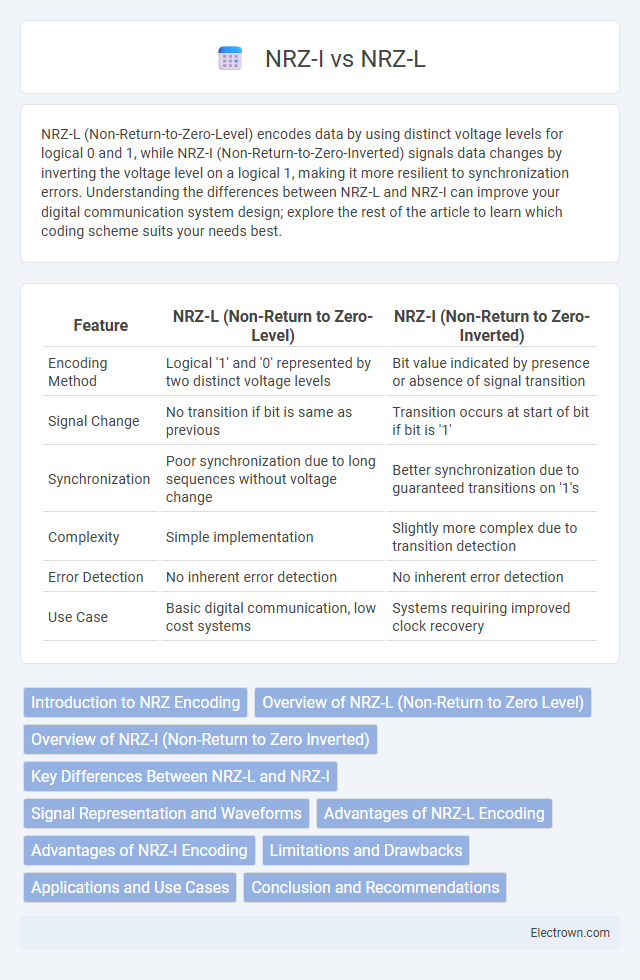NRZ-L (Non-Return-to-Zero-Level) encodes data by using distinct voltage levels for logical 0 and 1, while NRZ-I (Non-Return-to-Zero-Inverted) signals data changes by inverting the voltage level on a logical 1, making it more resilient to synchronization errors. Understanding the differences between NRZ-L and NRZ-I can improve your digital communication system design; explore the rest of the article to learn which coding scheme suits your needs best.
Table of Comparison
| Feature | NRZ-L (Non-Return to Zero-Level) | NRZ-I (Non-Return to Zero-Inverted) |
|---|---|---|
| Encoding Method | Logical '1' and '0' represented by two distinct voltage levels | Bit value indicated by presence or absence of signal transition |
| Signal Change | No transition if bit is same as previous | Transition occurs at start of bit if bit is '1' |
| Synchronization | Poor synchronization due to long sequences without voltage change | Better synchronization due to guaranteed transitions on '1's |
| Complexity | Simple implementation | Slightly more complex due to transition detection |
| Error Detection | No inherent error detection | No inherent error detection |
| Use Case | Basic digital communication, low cost systems | Systems requiring improved clock recovery |
Introduction to NRZ Encoding
NRZ-L (Non-Return-to-Zero-Level) encoding represents binary data through two distinct voltage levels, where a high voltage typically signifies a binary '1' and a low voltage indicates a binary '0'. NRZ-I (Non-Return-to-Zero Inverted) encoding, in contrast, signals a binary '1' by inverting the current voltage level, while a binary '0' causes no change. Both NRZ-L and NRZ-I are fundamental forms of NRZ encoding used in digital communication to map binary sequences into electrical signals without returning to a zero or baseline voltage between bits.
Overview of NRZ-L (Non-Return to Zero Level)
NRZ-L (Non-Return to Zero Level) encoding represents binary data by assigning a fixed voltage level for each bit: a high voltage for one binary state and a low voltage for the other, without returning to zero between bits. This method offers straightforward implementation and efficient bandwidth usage but lacks inherent error detection capability. Understanding NRZ-L is essential for comparing it with NRZ-I, which encodes data via transitions rather than voltage levels.
Overview of NRZ-I (Non-Return to Zero Inverted)
NRZ-I (Non-Return to Zero Inverted) is a line coding scheme where a logical '1' causes a transition in the signal level, while a logical '0' maintains the current signal state. This method enhances synchronization by ensuring a transition occurs with each '1', reducing ambiguity during data recovery compared to NRZ-L (Non-Return to Zero Level). NRZ-I is widely used in communication systems that require reliable clock recovery without increased bandwidth consumption.
Key Differences Between NRZ-L and NRZ-I
NRZ-L (Non-Return-to-Zero-Level) encodes data by representing logical '1' and '0' with distinct voltage levels, where a specific voltage level corresponds directly to the bit value. NRZ-I (Non-Return-to-Zero Inverted) encodes data by indicating a logical '1' through a transition or change in voltage level, while a logical '0' is represented by no change from the previous level. Your choice between NRZ-L and NRZ-I impacts signal interpretation, with NRZ-I providing better synchronization capabilities in long data sequences due to its reliance on voltage transitions.
Signal Representation and Waveforms
NRZ-L (Non-Return-to-Zero-Level) encodes data by assigning a fixed voltage level to each binary state, where a high voltage represents a binary '1' and a low voltage represents a binary '0,' resulting in a straightforward and continuous waveform. NRZ-I (Non-Return-to-Zero-Inverted) differentiates data based on signal transitions; a change in voltage indicates a binary '1,' while no change corresponds to a binary '0,' producing a waveform dependent on the presence or absence of signal inversions. Understanding these signal representation methods helps you accurately interpret waveform patterns and design communication systems with reliable data encoding.
Advantages of NRZ-L Encoding
NRZ-L encoding offers simplicity in implementation, making it easier to design and troubleshoot communication systems. It provides straightforward signal representation with a direct correlation between voltage level and binary data, which minimizes errors during transmission. Your system benefits from lower power consumption and reduced bandwidth requirements compared to more complex encoding schemes.
Advantages of NRZ-I Encoding
NRZ-I (Non-Return-to-Zero Inverted) encoding offers robustness against synchronization errors by encoding data changes rather than absolute signal levels, making it less prone to baseline wander compared to NRZ-L. This characteristic enhances clock recovery in long data transmissions, improving signal integrity in serial communication systems. NRZ-I's differential nature simplifies error detection and increases reliability in noisy environments, especially in fiber optic and magnetic storage applications.
Limitations and Drawbacks
NRZ-L (Non-Return-to-Zero-Level) struggles with synchronization issues due to its constant voltage levels, making it difficult to distinguish long sequences of identical bits. NRZ-I (Non-Return-to-Zero-Inverted) improves synchronization by encoding data based on signal transitions rather than levels but still suffers from baseline wander and susceptibility to noise, especially in long runs of zeros. Both encoding schemes lack inherent error detection, necessitating additional mechanisms for reliable data transmission in high-speed or noise-prone environments.
Applications and Use Cases
NRZ-L (Non-Return-to-Zero-Level) is commonly used in simple digital communication systems where the signal level directly represents the binary data, making it suitable for low-complexity applications like serial data transmission and storage devices. NRZ-I (Non-Return-to-Zero Inverted) finds frequent application in asynchronous communication protocols and magnetic recording, as it encodes data based on signal transitions, providing better synchronization capabilities. Your choice between NRZ-L and NRZ-I depends on requirements for timing accuracy, error detection, and the nature of the communication channel.
Conclusion and Recommendations
NRZ-L and NRZ-I encoding methods differ primarily in how they interpret signal changes, with NRZ-L representing bits by voltage levels and NRZ-I relying on transitions for data interpretation. For applications requiring higher immunity to synchronization errors, NRZ-I offers better performance by encoding data based on signal transitions rather than static voltage levels. Your choice should consider system complexity and error tolerance, with NRZ-I recommended for environments prone to signal degradation or timing issues.
NRZ-L vs NRZ-I Infographic

 electrown.com
electrown.com